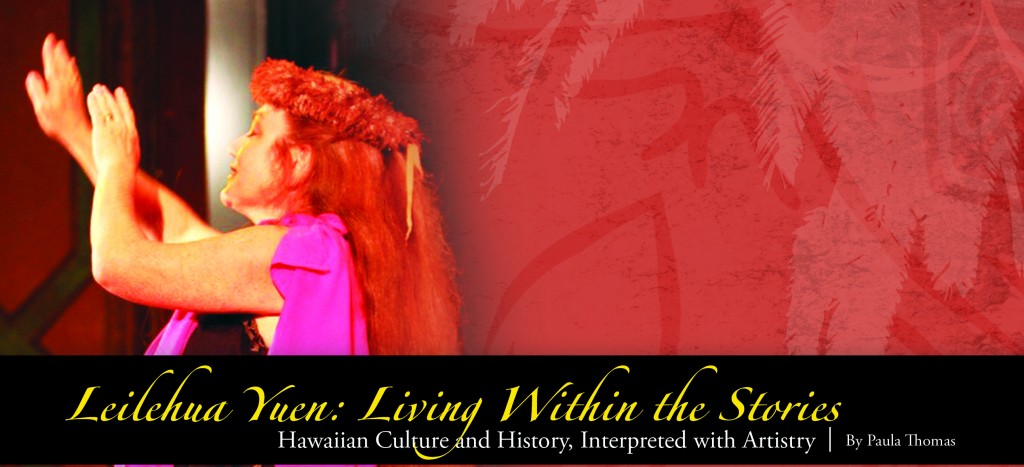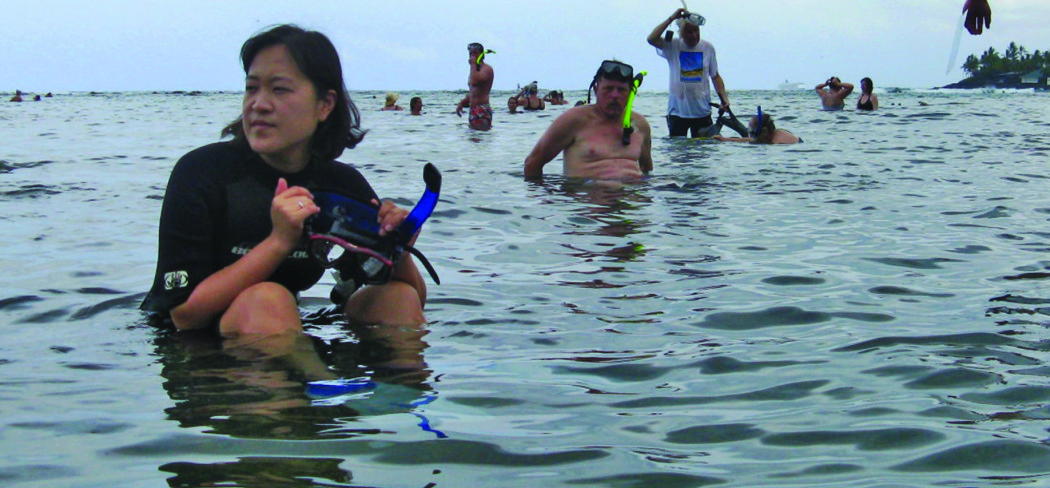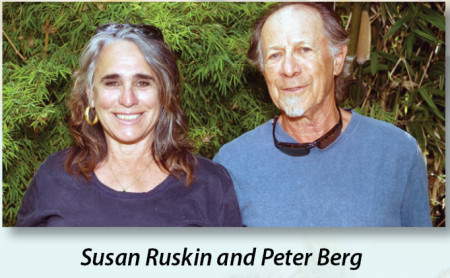Lelehua Yuen: Living Within the Stories
Hawaiian Culture and History, Interpreted with Artistry
By Paula Thomas
She is bathed in bright light on stage in a white mu‘umu‘u, her hands ever so delicately miming the picking of a lei blossom and bringing it close for its sweet scent, her movements like floating silk. I was lost in the grace of it all.
Such is the artistry of Leilehua Yuen: storyteller, dancer, singer, artist and Hawaiian cultural specialist.
The occasion happened to be Hawai‘iana Live!, the ongoing Wednesday-morning cultural performance at Hilo’s Palace Theater, now in its sixth year. Yuen conceived of and continues to design the performances that differ each week. In April-May they focus on lei-making, one of her favorite subjects. Otherwise, the stories are roughly based on topics suggested by the Hawaiian lunar calendar. In fall and winter, for example, the shows are about Makahiki (Hawaiian New Year) and focus on the rains and watershed environment. The Wednesday after the first snowfall of winter is devoted to stories of Poli’ahu, goddess of Mauna Kea. So they cover a range of Hawaiiana, hence the title of the production. Nearly always accompanying her is Manu Josiah, her husband, companion and fellow artist/musician.
When I asked him how long he has known Leilehua, I already knew from his expression what was coming: “forever,” he said. In truth, they have known each other for many years and married six years ago, now making their home in her grandparents’ house, which they are slowly restoring.
They make a perfect pair: both deeply spiritual, both rooted in their culture, both committed to revitalization, both attentive to the mission to teach and entertain—edutainment, they call it. It’s not an uncommon term, and it justly suits what they do: educating and entertaining with an underlying purpose to perpetuate the Hawaiian culture as authentically as possible.
One Story at a Time
“Art should not get easier, but better,” she quotes. “For a story to be good, it has to be true — to the human heart. I don’t care for stories that go for the quick laugh. When the kernel of a story is true, we laugh because we relate to the truth of the human condition.”
For Leilehua, telling and teaching stories is all-consuming, and it takes many, many forms. In addition to Hawai‘i-ana Live!, she and Manu “edutain” through Recycle Hawai‘i’s “Artists in the Environment” program under Howard Shapiro; they put on “Malalo O Ka Pō Lani – Hawaiian Culture Night,” a monthly presentation of the Institute for Astronomy and Mauna Kea Support Services; perform hula “informances” for Volcano Art Center at Hawai‘i Volcanoes National Park; and she produces Hilo’s Lei Day (leiday.net) program every year — now held at the East Hawai‘i Cultural Center. These are just a few of their regular engagements. The pair does presentations, workshops and activities through the Univeristy of Hawai‘i, Hilo Conference Center, and performs at many festivals and private functions.
Lately, though, Leilehua and Manu have made time to do some of their own performing and recording. Their latest CD, “A Makahiki Carol,” won the Children’s Music award, and “By Moonlight, By Sunlight” won for spoken word at the Big Island Music Awards (BIMA) banquet held on April 2, 2012. Their story, “Why Summer Days are Long, A Hawaiian Story About the Sun,” won honors from Storytelling World Awards 2012.
Why they are so good at their trade is no secret to them. Leilehua spends much time researching the stories, legends and myths of Hawai‘i, many of which she learned originally from her kūpuna. She also uses her vast collection of books and clippings, online sites, and she delves into archives, such as the old Hawaiian newspapers now searchable online through the Bishop Museum and other sources. What has made the research especially rewarding and exciting for her is being able to bring forgotten stories to life and finding the missing pieces of incomplete stories she learned long ago, she says.
They also understand that a good story will come across if you truly know the story. Not from memory, not just the words of it, but the meaning, the feeling, the point of it. Manu quietly reflects, “Culture includes staying pono within it. Storytellers have many lessons to share, and stories affect people in different ways. People take what they need to hear from stories; they are like medicine. They affect everyone in a different way. And, they affect people different ways at different times. It all depends on what you are ready to hear.”
The talent and skill of Leilehua is hard-earned. A student of the legendary Aunty Nona Beamer, Leilehua notes that she was learning all the time, because Aunty Nona never wasted a minute. She was constantly teaching and took advantage of opportunities: waiting in an airport lounge, for example, was never down time. “She held herself and everyone she taught to a very high standard, because she understood that being a role model came with responsibility. Aunty Nona opened her heart to everyone.”
Leilehua has deep roots in Hawai‘i. Her father, Don Yuen, was born here of Hawaiian heritage and the family comes from Hanapepe on Kaua‘i, across the channel from Ni‘ihau. It’s not surprising, therefore, that Hawai‘iana Live! contains some history of lei-making with the prized Ni‘ihau shells.
As a young girl, the daughter of working artists and storytellers, Yuen went back and forth between Hawai‘i and California, as she had extended family in both places. She got used to traveling, performing, being around people who did things. When she was young, her parents went their separate ways and she remained in Hawai‘i, where her father’s parents helped raise her in the house just off Waianuenue Avenue. She notes, laughing, “between Hilo Union, Hilo Intermediate, Hilo High School and South One, you could spend your whole life on Waianuenue Avenue!”
One of the things she appreciates about being raised by elders is the attention that was paid to reflection and the past. “It may seem like you are taking two steps forward and one step back; but moving forward and then stepping back and reflecting gave me a strong foundation and a sense of continuity, while encouraging a willingness to try new things.” This process of learning and reflecting, of merging the present with the past and blending the new with the old, is how she has learned to live life.
I asked Leilehua what she dreamed of doing when she was younger and what appealed to her besides art, if anything. Her answer was: journalism. “I really got into writing and my fantasy was to live in the rainforest and have a motorcycle and a plane; and when I was called on a job, I’d get on my bike, ride to my plane and fly to someplace exotic and exciting to cover some dramatic story, then off to my editor’s office, maybe in New York, and deliver my story . . .”
As fate would have it, Leilehua got a chance to pursue her dream when, while in college, Space Age Publishing Company (SPC), now based in Waimea, hired her. She worked with SPC (much of the time as an outside consultant) for 17 years, traveling to cities like Hainan, Beijing, Jakarta, Vancouver, Toronto and Frankfurt, as well as mainland U.S. cities, meeting people she found to be amazing. A career highlight was guiding astronaut John Young (commander of Apollo 16 in 1972) on a personal tour of Mauna Kea.
Over the years, she has herself had a number of businesses, often concurrently. With 9/11, her tour business collapsed, and with it most of her income. Unable to afford the $500 per month in gas her aging Jeep Cherokee cost commuting to her teaching job, she sold the decrepit vehicle and bought a 450cc Honda Nighthawk motorcycle to make the Saddle Road commute. Years later, the cycle would be important. It was a Labor Day weekend, and Manu emailed her from O‘ahu asking her to guide him and 17 of his Harley-owning friends on a cycle tour of the Big Island. She agreed. That weekend marked a shift in their relationship that eventually led to Manu moving to Hawai‘i Island. Although that was years ago, they both still ride.
One of Leilehua’s distinguishing features is her hair. When it’s down, it nearly reaches the ground, falling 52 inches from the nape of her neck. You might think that she has never cut it but she has, twice, and both times proved to be disastrous emotionally. It was when she met Aunty Nona in around 1994, that her hair took on more symbolic meaning for her—representing her cultural heritage and honoring her teacher. Aunty Nona asked her not to cut it anymore, and to this day she has not. It is an act of respect to do what your kumu asks of you. “I will always be a student,” she says, “because I won’t cut my hair.” It falls and shimmers like a waterfall down her back, and she carries it with strength and elegance, as if it weighed nothing at all.
The more Leilehua Yuen works as an artist, the more she learns, and the more everything comes back to story. “Story defines culture . . .. Nothing is separated from anything else. You need physics to understand how to make art and vice-versa.”
“And culture,” Manu adds. “Culture is the context in which you live your life. It’s in the koko, meaning it flows in your veins, the same as it did with our ancestors. It influences your decisions on food, family, work, patterns, activities you choose to do .. All human endeavor takes place in a cultural context. ”
As a cultural specialist doing monthly presentations on Mauna Kea, Leilehua has strong ideas about science and culture. The two are not separated. “Science is not just a collection of data or instruments. It’s a method of inquiry: observing and absorbing. It’s the same system, the same process. . . . With a fishnet, which string is the most important? It’s all one string. Which knot is most important? All knots are important. If there is a hole, the fishnet as a system is broken. Manu adds, “A warrior’s spear, is it just a weapon? He can always use the other end as a hoe, or as a bar of defense. Everything has its context.”
From a cultural perspective, each of us is a knot. We are all important. When we see things separately, is it an error of judgment or is it a difference in interpretation? The answer is sometimes: how are you holding it in the light?
She and Manu merge their talents in many ways. In addition to performances, they have created LeiManu Designs, a business that first and foremost carries forth the legacy of her father, Don, and the Malama Torch™ he originally designed for the Mauna Kea Beach Hotel. All of the torches are manufactured by Leilehua and Manu in their Hawai‘i Island workshop, where they also do custom work. “It’s great to be able to carry on a family business,” Leilehua says. “I starting out sweeping the shop, then drawing the designs, and finally being trusted with a torch in my hand. Manu got interested in the business, too, so he trained with Dad as well.
Leilehua does most of the metalwork, while Manu has started working in wood—of all kinds. They were featured artists recently at the Volcano Art Center Gala. Her dad still helps, especially in the design phase of a project, to suggest alternative approaches, and help solve technical problems, like armature stresses and electrolysis issues. Geraldine Duncann, Leilehua’s mother and also an artist, has always been very encouraging of her rather eclectic career. She is a writer, ceramicist, painter, doll maker, and amazing at historical costume reconstruction.
While eclectic may describe Leilehua Yuen’s career, it is deeply rooted in intention and a profound cultural current. “To be able to pass on spiritual mana and wisdom, you have to be coming from the right place,” she says. She and Manu do pī kai before performances sometimes, to cleanse and prepare. When she is on stage Leilehua is spellbinding. There is a reason:
“I live within the stories,” she says.❖
Leilehua’s website: Leimanu.com.



